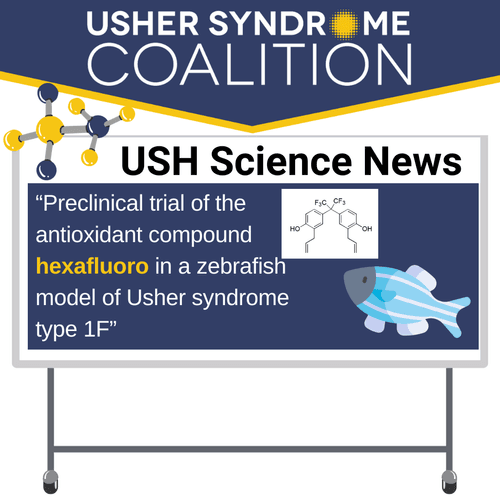Grounded in Science
A balance of research news and well-being for the Usher syndrome community.
Happy New Year!
We're eagerly anticipating another year of progress and connection with all of you. We're especially looking forward to our hybrid USH2024 Connections Conference. This is the largest gathering of the Usher syndrome (USH) community and will take place both in-person in Rochester, New York, and online, July 19-20. We hope you will join us for this event! Register Today
We are also excited to share that information about Usher syndrome (including downloadable brochures for families, health care professionals, and educators) is available in Spanish (Recursos en Español)! This includes information curated in collaboration with the National Center on DeafBlindness (NCDB), available on the NCDB website: Identificación del síndrome de Usher: información y recursos.
Have you joined the Usher Syndrome Coalition Discord Community Server? It’s a safe place for the community to connect with each other. Join here: https://discord.gg/czwHGaDu7W
Research Spotlight
Childhood Deafblindness
UsherKids Australia is a parent-led organization that aims to empower the Usher community through support, connection, and knowledge. Emily Shepard of UsherKids Australia recently published a paper titled "Exploring methodologies for establishing prevalence of deafblindness in children: A scoping review" in the British Journal of Visual Impairment. She worked with a team of researchers to conduct a comprehensive review to reveal the complexities in defining, assessing, and diagnosing childhood deafblindness to determine the prevalence of deafblindness in children. A few of their key findings are:
The literature on deafblindness in children highlights a lack of comprehensive descriptions of the characteristics and needs of this population.
Inconsistencies among researchers in defining, assessing, and diagnosing deafblindness pose challenges for meaningful comparisons.
Accurate descriptions of the childhood deafblind population are crucial for understanding their unique needs.
They recognize the need for continued research and a unified effort to describe and address the needs of children with deafblindness accurately. They recommend assessing this population with the aim of paving the way for future studies and interventions.
Earlier in 2023, Emily also published a paper titled “Awareness of Usher Syndrome and the Need for Multidisciplinary Care: A Cross-Occupational Survey of Allied Health Clinicians,” where she aimed to find out how aware of Usher syndrome healthcare clinicians are, specifically audiologists, optometrists, and orthoptists. To ensure the best care for those affected, a team of different healthcare professionals is needed. The results of this study highlight that healthcare clinicians need more education about Usher syndrome to provide better care. It is also essential to help them recognize the valuable roles of different healthcare professionals in multidisciplinary care so that appropriate referrals occur.
Check out our Current USH Research page specific to USH subtype as well as gene-independent therapeutic approaches.
In Case You Missed It: Science News Feature
Preclinical trial of the antioxidant compound hexafluoro in a zebrafish model of Usher syndrome type 1F
May 1, 2023: USH1F is one of the subtypes of Usher syndrome type 1, caused by mutations in the PCDH15 gene. Mutations to the PCDH15 gene result in a dysfunctional protocadherin-15 protein, changing the structure and function of hair cells in the inner ear and photoreceptor cells in the eye. This results in the death of these cells which leads to hearing and vision loss.
Researchers used zebrafish models of USH1F to see if the antioxidant compound hexafluoro could improve the visual function of the zebrafish with USH1F. Hexafluoro is a synthetic compound that takes honokiol, a compound naturally found in the bark of magnolia trees, and adds fluorine atoms. Their research found that hexafluoro could slow down photoreceptor cell death of zebrafish with USH1F, thus improving visual function. The researchers believe these data show that oxidative stress (which is when there is an imbalance of free radicals and antioxidants in a person’s body) could be a mechanism behind USH1F visual symptoms. They also suggest that hexafluoro may be able to stabilize the dysfunctional photoreceptors by preventing oxidative stress.
What this means for Usher syndrome: While this research is still at a very early stage, the results suggest that hexafluoro, or other antioxidants, may be a potential therapy to slow down photoreceptor cell death associated with Usher syndrome.
DISCLAIMER: The Usher Syndrome Coalition does not provide medical advice nor promote treatment methods. USH Science News is intended to help summarize more complex literature for the community to use at their own discretion.
For more science news, check out our Science News page, organized by treatment approach and type of Usher syndrome.
On Well-Being: Mental Wellness Month
January is Mental Wellness Month. According to the Global Wellness Institute, “Mental wellness is an internal resource that helps us think, feel, connect, and function; it is an active process that helps us to build resilience, grow, and flourish”...
USH Life Hack of the Month
(Send your USH life hacks to info@usher-syndrome.org.)
Sarah Turner, USH Ambassador for Michigan and Coalition volunteer, compiled this list of USH Tips for the Home, practical tips to make life easier and safer for those living with Usher syndrome.








